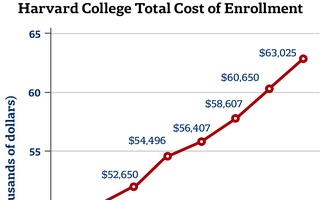A new study recently featured in The New York Times revealed significant inconsistencies regarding economic diversity at colleges around the country, Harvard included. There is a particularly strong association between family income and enrollment at the nation’s top universities, collectively called “Ivy plus” schools. According to the report, 67 percent of Harvard students come from families that have income levels in the top 20 percent, and the median income of the families of Harvard students is $168,800, placing Harvard in the top three percent of colleges in regard to both median income and top 20 percent of income levels. With these statistics, Harvard is under greater scrutiny for the large disparities in the economic makeup of its students.
Unfortunately, these numbers do not come as a surprise. The wealthiest percentiles of the nation’s population have historically been overrepresented in the admitted classesof Harvard and other “Ivy plus” institutions. The Harvard Admissions Office must take heed of this important report and continue to strive to make each incoming class as socioeconomically diverse as possible. Furthermore, the University should increase its local and national outreach, reaching students with relevant financial information and helpful college-prep programs like Crimson Summer Academy before the college application process even begins.
Harvard’s groundbreaking financial aid initiatives have been instrumental in dismantling barriers for low-income students to afford the cost of attending. However, the disproportionate amount of wealthy students affects the overall campus culture, which presents an environment that is unwelcoming and even discouraging for students from low-income backgrounds who consider applying. Students who are qualified need to be made aware that Harvard is an actual possibility for them, and this can only be done by more widespread outreach before senior year of high school. Moreover, giving these students the opportunity to attend Harvard regardless of their financial status is only half of the battle when, once admitted, they still do not feel like they have a place among their wealthier counterparts. University administration needs to ensure low-income students have the resources to know that they too have a claim to Harvard, so that they will not just matriculate, but stay and eventually graduate.
While the report revealed information about institutions of higher education across the nation, it is important that Harvard and other elite schools with more financial resources stand separately in consideration. They are held to a different standard and must be expected to act accordingly. We cannot blame the University for the national socioeconomic disparity, but it is fair to call on the administration to close the gaps in economic status that exist on campus and manifest themselves in student life. Harvard must commit to a socioeconomically diverse student body, but more importantly, Harvard must continue to prioritize this diversity for the good of every student’s experience.
Read more in Opinion
What is Offensive Can No Longer Be IgnoredRecommended Articles
-
Aid for the AffluentMy natural reaction when I read that a family making $180,000 per annum will possibly qualify for financial aid is
-
Parent Pleads Guilty of Defrauding College of Financial AidJoseph N. Fonge and his wife Barbara E. Fonge reported false income figures to the University to defraud the College of financial aid funding for their child, who graduated from the College in 2013.
-
 Obama Colleagues Summers and Furman Talk Economic Growth
Obama Colleagues Summers and Furman Talk Economic Growth -
 College Forms ‘Start-Up’ Freshman Grants, Increases Tuition
College Forms ‘Start-Up’ Freshman Grants, Increases Tuition -
 Median Family Income for Harvard Undergrads Triple National Average, Study Finds
Median Family Income for Harvard Undergrads Triple National Average, Study Finds













